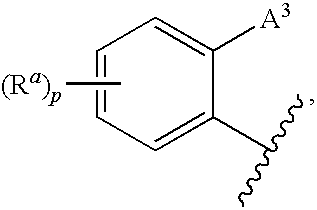CETP inhibitors
a technology of hdl-c and inhibitors, applied in the field of ccetp inhibitors, can solve the problems of chd risk, high risk of statins, and true burden on health care systems, and achieve the effect of only reducing the risk of approximately one-third
- Summary
- Abstract
- Description
- Claims
- Application Information
AI Technical Summary
Benefits of technology
Problems solved by technology
Method used
Image
Examples
example 1
[0188]
(4S,5R)-5-[3,5-bis(trifluoromethyl)phenyl]-3-[2-[(diethylamino)methyl]-5-(trifluoromethyl)benzyl]-4-methyl-1,3-oxazolidin-2-one
[0189]To a solution of 2-({(4S,5R)-5-[3,5-bis(trifluoromethyl)phenyl]-4-methyl-2-oxo-1,3-oxazolidin-3-yl}methyl)-4-(trifluoromethyl)benzaldehyde (14.5 mg, 0.0291 mmol) in dichloroethane (300 μL) was added HNEt2 (4.6 μL, 0.0436 mmol), and NaBH(OAc)3 (9.2 mg, 0.0436 mmol). The reaction was stirred at room temperature for 18 hours and then diluted with EtOAc (10 mL) and washed with brine (5 mL). The organic layer was dried over Na2SO4, filtered, and concentrated. Purification of the residue by PTLC (50% EtOAc / hexanes) afforded (4S,5R)-5-[3,5-bis(trifluoromethyl)phenyl]-3-[2-[(diethylamino)methyl]-5-(trifluoromethyl)benzyl]-4-methyl-1,3-oxazolidin-2-one. Rf=0.57 (50% EtOAc / hexanes). LCMS=557.2 (M+1)+. 1H NMR (CDCl3, 500 MHz) δ 7.92 (s, 1H), 7.82 (s, 2H), 7.55-7.52 (m, 3H), 5.76 (d, J=8.0 Hz, 1H), 5.03 (d, J=16.1 Hz, 1H), 4.60 (d, J=16.1 Hz, 1H), 4.05-4.03 ...
example 7
[0192]
(4S,5R)-5-[3,5-bis(trifluoromethyl)phenyl]-3-[2-{[cyclobutyl(ethyl)amino]methyl}-5-(trifluoromethyl)benzyl]-4-methyl-1,3-oxazolidin-2-one
[0193]To a solution of (4S,5R)-5-[3,5-bis(trifluoromethyl)phenyl]-3-[2-[(cyclobutylamino)methyl]-5-(trifluoromethyl)benzyl]-4-methyl-1,3-oxazolidin-2-one (3.6 mg, 6.50×10−3 mmol) in dichloroethane (300 μL) was added acetaldehyde (40 μL, 0.709 mmol) and NaBH(OAc)3 (excess). The reaction was stirred at room temperature for 2 hours and then diluted with EtOAc (10 mL) and washed with brine (5 mL). The organic layer was dried over Na2SO4, filtered, and concentrated. Purification of the residue by PTLC (25% EtOAc / hexanes) afforded (4S,5R)-5-[3,5-bis(trifluoromethyl)phenyl]-3-[2-{[cyclobutyl(ethyl)amino]methyl}-5-(trifluoromethyl)benzyl]-4-methyl-1,3-oxazolidin-2-one. Rf=0.69 (25% EtOAc / hexanes). LCMS=583.2 (M+1)+. 1H NMR (CDCl3, 500 MHz) δ 7.90 (s, 1H), 7.80 (s, 2H), 7.54-7.52 (m, 3H), 5.74 (d, J=8.0 Hz, 1H), 4.99 (d, J=16.1 Hz, 1H), 4.65 (d, J=16....
example 8
[0194]
(4S,5R)-5-[3,5-bis(trifluoromethyl)phenyl]-4-methyl-3-[2-[(propylamino)methyl]-5-(trifluoromethyl)benzyl]-1,3-oxazolidin-2-one (TFA salt)
[0195]To a solution of (4S,5R)-5-[3,5-bis(trifluoromethyl)phenyl]-3-[2-(bromomethyl)-5-(trifluoromethyl)benzyl]-4-methyl-1,3-oxazolidin-2-one (27 mg, 0.0479 mmol) in MeCN (0.5 mL) was added n—PrNH2.HCl (5.5 mg, 0.0575 mmol) and i—Pr2NEt (20.8 μL, 0.120 mmol). The solution was heated at 80° C. for 16 hours. The reaction was then cooled to room temperature and purified by reverse-phase chromatography (C-18, 10 to 95% MeCN / water with 0.1% TFA). The fractions containing the desired product were lyophilized to afford (4S,5R)-5-[3,5-bis(trifluoromethyl)phenyl]-4-methyl-3-[2-[(propylamino)methyl]-5-(trifluoromethyl)benzyl]-1,3-oxazolidin-2-one (TFA salt). LCMS=543.1 (M+1)+. 1H NMR (CDCl3, 500 MHz) δ 9.72 (s, 2H), 7.90 (s, 1H), 7.76 (s, 2H), 7.72 (d, J=6.9 Hz, 1H), 7.56 (d, J=6.4 Hz, 1H), 7.49 (s, 1H), 5.87 (d, J=7.5 Hz, 1H). 4.98 (d, J=15.3 Hz, 1H),...
PUM
| Property | Measurement | Unit |
|---|---|---|
| density | aaaaa | aaaaa |
| volume | aaaaa | aaaaa |
| volume | aaaaa | aaaaa |
Abstract
Description
Claims
Application Information
 Login to View More
Login to View More - R&D
- Intellectual Property
- Life Sciences
- Materials
- Tech Scout
- Unparalleled Data Quality
- Higher Quality Content
- 60% Fewer Hallucinations
Browse by: Latest US Patents, China's latest patents, Technical Efficacy Thesaurus, Application Domain, Technology Topic, Popular Technical Reports.
© 2025 PatSnap. All rights reserved.Legal|Privacy policy|Modern Slavery Act Transparency Statement|Sitemap|About US| Contact US: help@patsnap.com



